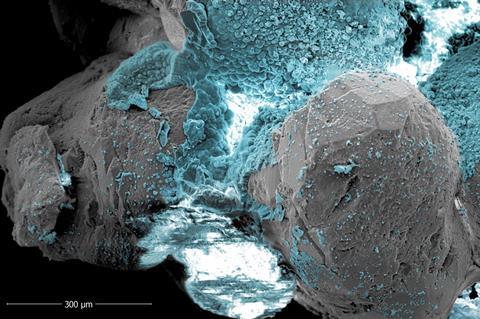Turning soft beaches into hard rock. American researchers managed this (at least on lab scale) by exposing sea-soaked sand to a mild electric current.
Around the world, coastal areas are threatened by erosion. Dikes, embankments, artificial reefs and other constructions can protect these areas to a certain extent, but researchers at Northwestern University present a completely new approach in Communications Earth & Environment: create natural cement by zapping wet sands with an electric current.
Alessandro Rotta Loria and his team got the idea from molluscs that use the minerals dissolved in seawater to build their own rock-hard shells. We could try something similar, they thought. In their lab, they sent a mild current through sand soaked in seawater and witnessed an instantaneous transformation of the sand into a hard, rock-like chunk.

This microscopic image, on micrometer scale, shows the mineral ‘cement’ in blue holding the grains of sand (grey) together. Whether this approach also works on real-life beaches (and what that means for bathers and marine life) remains to be seen. Interesting detail: the research is funded by the US Army Research Office. Apparently, the American army is recognizing the potential.
Andony Landivar Macias, Steven Jacobsen & Alessandro Rotta Loria, Electrodeposition of calcareous cement from seawater in marine silica sands, Communications Earth & Environment (2024), doi:10.1038/s43247-024-01604-3













Nog geen opmerkingen